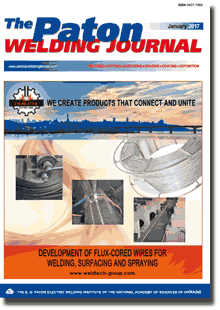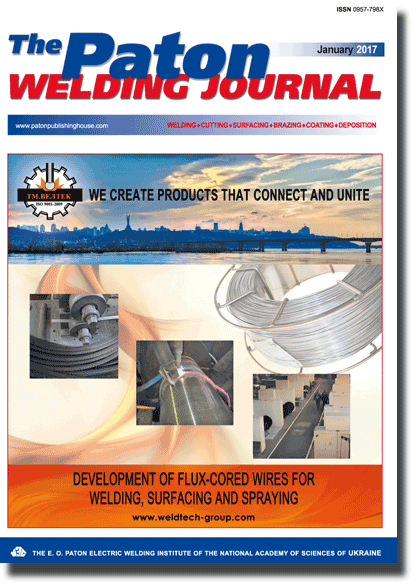Access for download PDF files for subscribers and for reviewers of scientometric bases.
Organization: Elsevier for content access(PDF files of journals released before 2024 are available for download from the website's archives))
Organization: Elsevier for content access(PDF files of journals released before 2024 are available for download from the website's archives))
| 2017 №01 (09) |
DOI of Article 10.15407/tpwj2017.01.10 |
2017 №01 (11) |

The Paton Welding Journal, 2017, #1, 54-57 pages
Flux-cored wire for wear-resistant surfacing of thin-sheet structures
A.A. Babinets and I.A. Ryabtsev
E.O. Paton Electric Welding Institute, NASU 11 Kazimir Malevich Str., 03680, Kiev, Ukraine. E-mail: office@paton.kiev.ua
Abstract
The electric arc surfacing of wear-resistant layers on sheet structures of less than 4 mm thickness is connected with a risk of occurrence of burn-outs and excessive deformation of sheets due to their high penetration. One of the possible ways to decrease penetration is the selection of an optimum method of surfacing and development of appropriate technologies and surfacing materials. It was experimentally found, that to provide a minimum penetration with account for a quality formation of deposited metal is possible by using the open-arc surfacing with a flux-cored wire of less than 1.6 mm diameter. The application of the developed technology and technique of surfacing using an improved self-shielding flux-cored wire PP-AN198 provided a quality formation of the deposited metal, absence of burn-outs, pores and other defects, as well as reduced the residual deformations in surfacing of sheets of 3 mm thick steel St3 to minimum. The obtained results can be used in selection of surfacing materials and technologies for surfacing the wear-resistant layers on thin-sheet structures, which are operating in mining and metallurgical industries under the conditions of different types of abrasive wear. 8 Ref., 1 Table, 3 Figures.
Keywords: arc surfacing, flux-cored wire, thin-sheet structures, penetration, deformations, deposited metal
Received: 16.02.17
Published: 23.11.16
References
- Pokhodnya, I.K., Suptel, A.M., Shlepakov, V.N. (1972) Flux-cored welding. Kiev: Naukova Dumka.
- Pokhodnya, I.K., Yavdoshchin, I.R., Paltsevich, A.P. et al. (1994) Metallurgy of arc welding, interaction of metal with gases. Kiev: Naukova Dumka.
- Pokhodnya, I.K., Shlepakov, V.N., Maksimov, S.Yu. et al. (2010) Research and developments of the E.O. Paton Electric Welding Institute in the field of electric arc welding and surfacing using flux-cored wire (Review). The Paton Welding J., 12, 26–33.
- Yuzvenko, Yu.A., Kirilyuk, G.A. (1973) Flux-cored surfacing. Moscow: Mashinostroenie.
- Ryabtsev, I.A. (2004) Surfacing of machine parts and mechanisms. Kyiv: Ekotekhnologiya.
- Kondratiev, I.A., Ryabtsev, I.A. (2014) Flux-cored wires for surfacing of steel hot mill rolls. The Paton Welding J., 6/7, 95–96. https://doi.org/10.15407/tpwj2014.06.20
- Lankin, Yu.N., Ryabtsev, I.A., Soloviov, V.G. et al. (2014) Effect of electric parameters of arc surfacing using flux-cored wire on process stability and base metal penetration. Ibid., 9, 25–29. https://doi.org/10.15407/tpwj2014.09.03
- Babinets, A.A., Ryabtsev, I.A., Panfilov, A.I. et al. (2016) Influence of methods of arc surfacing with flux-cored wire on penetration of base metal and formation of deposited metal. Ibid., 11, 17–22. https://doi.org/10.15407/tpwj2016.11.03
Suggested Citation
A.A. Babinets and I.A. Ryabtsev (2017) Flux-cored wire for wear-resistant surfacing of thin-sheet structures. The Paton Welding J., 01, 54-57.The cost of subscription/purchase order journals or individual articles
| Journal/Currency | Annual Set | 1 issue printed |
1 issue |
one article |
| TPWJ/USD | 384 $ | 32 $ | 26 $ | 13 $ |
| TPWJ/EUR | 348 € | 29 € | 24 € | 12 € |
| TPWJ/UAH | 7200 UAH | 600 UAH | 600 UAH | 280 UAH |
| AS/UAH | 1800 UAH | 300 UAH | 300 UAH | 150 UAH |
| AS/USD | 192 $ | 32 $ | 26 $ | 13 $ |
| AS/EUR | 180 € | 30 € | 25 € | 12 € |
| SEM/UAH | 1200 UAH | 300 UAH | 300 UAH | 150 UAH |
| SEM/USD | 128 $ | 32 $ | 26 $ | 13 $ |
| SEM/EUR | 120 € | 30 € | 25 € | 12 € |
| TDNK/UAH | 1200 UAH | 300 UAH | 300 UAH | 150 UAH |
| TDNK/USD | 128 $ | 32 $ | 26 $ | 13 $ |
| TDNK/EUR | 120 € | 30 € | 25 € | 15 € |
AS = «Automatic Welding» - 6 issues per year;
TPWJ = «PATON WELDING JOURNAL» - 12 issues per year;
SEM = «Electrometallurgy Today» - 4 issues per year;
TDNK = «Technical Diagnostics and Non-Destructive Testing» - 4 issues per year.


